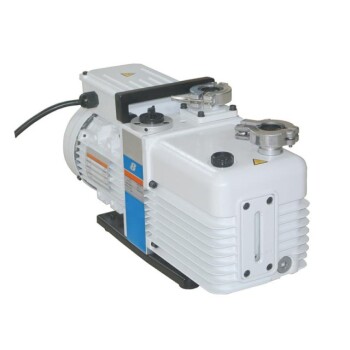Diffusion pumps are critical components in high-vacuum systems, and their performance heavily relies on proper maintenance, particularly regarding oil changes. The frequency of oil changes in a diffusion pump depends on factors such as usage, contamination levels, and operational conditions. Based on the references provided, oil changes are typically recommended every six months when the pump is cold. However, this interval may vary depending on the specific operational environment and the presence of contaminants. Regular monitoring of oil quality, oil level, and pump performance is essential to determine the optimal timing for oil replacement.
Key Points Explained:

-
Recommended Oil Change Interval
- The general guideline for changing the oil in a diffusion pump is every six months. This interval ensures that the oil remains effective in maintaining the pump's performance and prevents contamination from degrading the vacuum quality.
- The oil should be changed when the pump is cold to avoid safety hazards and ensure proper draining.
-
Factors Influencing Oil Change Frequency
- Contamination Levels: If the oil shows signs of contamination, such as discoloration or the presence of debris, it should be replaced immediately, regardless of the six-month interval. Contaminated oil can reduce pump efficiency and damage internal components.
- Operational Conditions: In environments with high particulate levels or frequent exposure to reactive gases, the oil may degrade faster, necessitating more frequent changes.
- Pump Usage: High-usage scenarios, such as continuous operation or heavy-duty applications, may require more frequent oil changes to maintain optimal performance.
-
Monitoring Oil Quality and Level
- Regularly check the oil level in the pump's oil window to ensure it is within the recommended range. Overfilling or underfilling can affect pump performance.
- Monitor the oil quality by observing its color and clarity. Clean, high-quality oil should appear clear and free of particles. Discoloration or cloudiness indicates contamination or degradation.
-
Steps for Changing the Oil
- Drain the Old Oil: Ensure the pump is cold before draining the oil to prevent burns or spills. Open the drain port and allow the oil to flow out completely.
- Clean the Pump: After draining, clean the pump internals thoroughly. This may involve disassembling the jet assembly and removing any residue or contaminants.
- Refill with New Oil: Use the recommended oil type (e.g., HFV-3) and fill the pump to the appropriate level as indicated in the oil window.
-
Additional Maintenance Considerations
- Heating Elements: Check the heating elements to ensure they are functioning correctly and are properly aligned. Misaligned or faulty heaters can lead to uneven heating and poor pump performance.
- Cooling System: Monitor the cooling water flow and temperature to ensure the pump operates within the recommended temperature range (10–35°C). Proper cooling prevents overheating and extends the pump's lifespan.
- Pump Body Temperature: Regularly measure the surface temperature of the pump body to ensure it remains within the specified range. Excessive heat can degrade the oil and damage internal components.
-
Signs That Oil Needs Replacement
- Reduced Pumping Speed: A noticeable decline in the pump's ability to achieve or maintain vacuum levels may indicate degraded oil.
- Increased Noise or Vibration: Unusual noises or vibrations during operation can signal oil contamination or insufficient lubrication.
- Visible Contamination: If the oil appears cloudy, discolored, or contains particles, it should be replaced immediately.
-
Importance of Regular Maintenance
- Regular oil changes and maintenance extend the lifespan of the diffusion pump and ensure consistent performance.
- Neglecting oil changes can lead to reduced efficiency, increased downtime, and potential damage to the pump and connected systems.
By following these guidelines and monitoring the pump's condition, users can determine the optimal oil change frequency for their specific application and ensure the diffusion pump operates at peak efficiency.
Summary Table:
| Aspect | Details |
|---|---|
| Recommended Interval | Every 6 months (when the pump is cold) |
| Key Factors | Contamination levels, operational conditions, and usage frequency |
| Monitoring | Check oil level, quality (color/clarity), and pump performance regularly |
| Signs for Replacement | Reduced pumping speed, increased noise/vibration, visible contamination |
| Maintenance Steps | Drain old oil, clean pump internals, refill with recommended oil type |
| Additional Checks | Heating elements, cooling system, and pump body temperature |
Ensure your diffusion pump operates at peak efficiency—contact our experts today for personalized maintenance advice!












